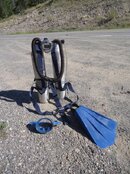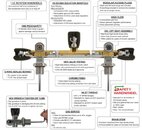I think it's been covered, but here it is in bullet point form:
1. Increased total gas supply for longer or deeper dives
2. Redundancy, because you have two first stages separating two second stages, and two inflation sources, so if one fails, you still have another one.
As dives get deeper or go into overhead environments, both of those things become increasingly important. You can provide yourself with both either by diving backmounted doubles, or by using a sidemount setup.
BTW, doubles DIVE wonderfully. They're just a PITA wherever gravity is relevant. I'd dive them all the time, everywhere, if somebody else would get them into and out of the water for me
1. Increased total gas supply for longer or deeper dives
2. Redundancy, because you have two first stages separating two second stages, and two inflation sources, so if one fails, you still have another one.
As dives get deeper or go into overhead environments, both of those things become increasingly important. You can provide yourself with both either by diving backmounted doubles, or by using a sidemount setup.
BTW, doubles DIVE wonderfully. They're just a PITA wherever gravity is relevant. I'd dive them all the time, everywhere, if somebody else would get them into and out of the water for me







